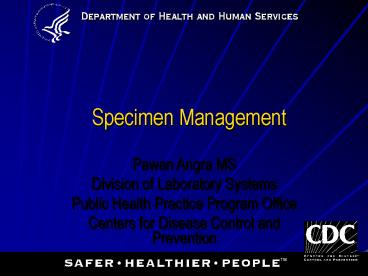Specimen Management - PowerPoint PPT Presentation
1 / 23
Title:
Specimen Management
Description:
Determine mode of transport. Courier, ambulance, clinic/lab staff ... Train all personnel responsible for collecting, handling, storage, transport of specimens ... – PowerPoint PPT presentation
Number of Views:104
Avg rating:3.0/5.0
Title: Specimen Management
1
Specimen Management
Pawan Angra MS Division of Laboratory
Systems Public Health Practice Program
Office Centers for Disease Control and Prevention
2
- The results of any laboratory tests are only as
good as the samples received in the laboratory
3
Specimen Management
- Specimen Collection
- Specimen Handling
- Specimen Transport
- Specimen Referral
- Specimen Storage
- Specimen Disposal
4
The Quality Assurance Cycle
Pre-Analytic
Patient/Client Prep Sample Collection
Personnel Competency Test Evaluations
Reporting
- Data and Lab Management
- Safety
- Customer Service
Post-Analytic
Sample Receipt and Accessioning
Record Keeping
Sample Transport
Quality Control
Testing
Analytic
5
Impact of Specimen Management on Patient Care
- Essential for accurate laboratory diagnosis
- Directly affects patient care and outcome
- Influences therapeutic decisions
- Impacts patient length of stay, hospital costs,
and laboratory costs - Influences laboratory efficiency
6
Pitfalls
- Saying Yes to everything
- Accepting every specimen
- Afraid to say No to physicians
- Someone with sufficient authority MUST support
laboratory policy - Good lab practice Patients first!
- Having no boundaries for technical issues
7
Pitfalls Lead to Errors Resulting In
- Delays in getting test results
- Unnecessary re-draws/re-tests
- Decreased customer satisfaction
- Increased costs
- Incorrect diagnosis / treatment
- Injury
- Death
8
Specimen Collection Procedures
- Should include instructions for
- Positively identifying the patient before
collecting a specimen - Required specimen for each requested test
- Preparation of patient
- Type of collection container, required volume,
timing - Preservation of specimen, e.g., transport media
- Proper specimen labeling
- Special handling instructions, e.g., refrigeration
9
Laboratory Handbook
- Compilation of documents that must be made
available to all specimen collection areas - Must be understood by all laboratory staff
- Includes
- Name and address of laboratory
- Contact names and telephone numbers
- Hours of operation
- List of available tests
- Specimen collection procedures
- Specimen transport procedures
- Expected turn around times (TAT)
- How stat requests are handled
- May be referenced in the Quality Manual
10
Test Requisition
- Patient identification
- Clinical data, where indicated
- Contact information for requesting physician or
authorized individual - Tests requested
- Time and date of specimen collection
- Source of specimen, when appropriate
11
Specimen Collection Laboratory Responsibilities
- Verify completeness of test request
- Verify integrity of the specimen
- Determine adequacy of specimen
- Appropriately labeled, legible identification
- Determine if appropriate specimen was submitted
for requested test - Identifier of the collector, e.g., phlebotomist,
patient - Enforce procedures for handling sub-optimum
specimens - Specimen rejection criteria
12
Specimen Rejection Criteria
- Unlabeled specimen
- Insufficient patient information
- Hemolyzed specimen
- Wrong tube drawn
- Wrong specimen submitted
- Inadequate volume for the amount of preservative
- Insufficient quantity
- Prolonged transport
13
Specimen Handling
14
Specimen Handling
- Handle all specimens as if infectious
- Use tracking system for all specimens
- Accession / logging process
- Confirm actual receipt of specimens
- Date and time of specimen receipt
- Track aliquots traceable to the original sample
15
Specimen Handling
- Establish procedures for handling
- Stat / urgent requests
- Delayed testing, e.g., storage, separation of
serum/plasma from cells - Leaking containers
- Contaminated forms
- Preservation of specimens
16
Specimen Transport
- Train personnel in appropriate safety and
packaging procedures - Package and preserve specimens appropriately
- Transport specimens at appropriate temperature
- Determine acceptable transport time
- Determine mode of transport
- Courier, ambulance, clinic/lab staff
- Adhere to the International Air Transport
Association (IATA) regulations
17
The Dangerous Goods Regulations
- Covers
- Packaging
- Labelling Packages
- Packing Instructions
- Documentation
- Training
- Are updated annually by IATA
18
Specimen Referral
- Record
- Tests / specimens referred
- Date of referral
- Name of person referring test
- Monitor / Track, and Record
- Turnaround time
- Results delivery (from referral lab, to
requestor) - Problems with referral
19
Specimen Storage
- Establish policy
- What should be stored?
- Determine retention time
- Determine storage location
- Consider ease of access
- Assure proper storage conditions
- Indexing of specimens
- By day of receipt or accession number
20
Specimen Storage
- Serum Banks
- Establish tracking procedures
- Encourage use of information technology
- Maintain an organized, accessible storage system
- Monitor freeze/thaw cycles
21
Specimen Disposal
22
Specimen Disposal
- Develop policy for disposal of medical waste
- Establish and follow disinfection procedures
- Comply with local regulations
- Include policy of disposal of rejected specimens
- Appoint someone with oversight responsibilities
- Establish a schedule to review all stored
specimens
23
Summary Avoiding Pitfalls
- Remember good laboratory practice
- Patients first!
- Train all personnel responsible for collecting,
handling, storage, transport of specimens - Monitor rejection log
- Routinely communicate with customers
- Update handbook, procedures when methods change































